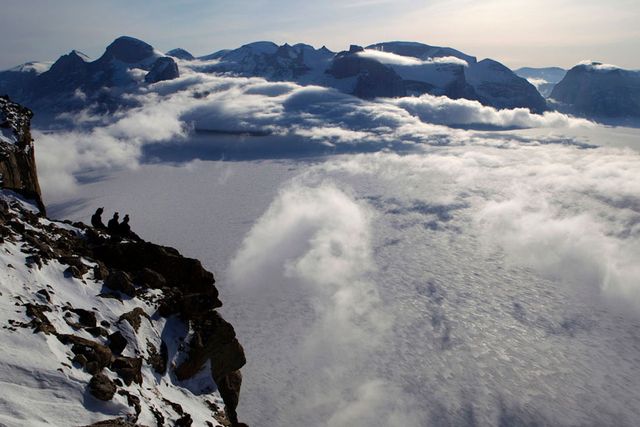
Australian adventure photographer has toughed out a lot of assignments in her first six years of shooting. When the now 25-year-old showed up to the Elephant Polo Championships in Nepal, there weren’t enough teams, so she volunteered for a new squad, hopped on the back of a pachyderm, and started swinging a 10-foot mallet. During a trip to Yangshuo, China to shoot climbers, she crashed a mountain bike into a ditch and lost a couple of her front teeth. A dentist shoved cotton over the exposed nerves and she finished her assignment. During a paragliding shoot in Pakistan, she and her partner crashed into a boulder on a steep hillside and that accident left her with a black eye, bruises all over her body, and fractured bones in her foot. Even though it led to an emergency evac on a homemade stretcher and a stay in a military hospital, she plans to go back next year to paraglide and shoot more. The only thing more fantastic than the spills she’s survived in foreign countries, are the photos she brings back. For one of her recent series, she went on a month-long trip to shoot BASE jumpers on Baffin Island. We caught up with her in Australia to find out more about it.
Click to view the full gallery BASE-Jumping Baffin Island.
Do you consider yourself an adventure photographer?
Yeah, certainly, that’s how I promote myself these days. I think when I’m back in Sydney everyone thinks I’m a nutcase. When I came back from that shoot in Pakistan all of the guys were just staring at me because I had crutches, a moon boot, and a red eyeball for five weeks. There were all just like, “You are insane.” But I didn’t think it was that bad. I’m just addicted to adventure. But I’m also addicted to going places you normally wouldn’t go. I think it’s for motivation—for the awesome feeling that results.
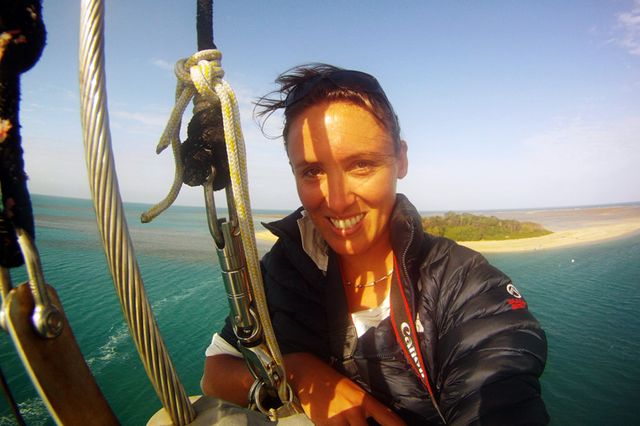
Was their one moment when you knew you could make it a career?
I got up really early one morning when there was a really good swell down on the Gold Coast and I drove to Snapper, and I shot this surfer walking out. At Snapper you get this backwash that happens, and when it hits a wave, it really jacks the water up. You know when you take a photo that’s pretty good. You know it’s pretty special. That was when I was 21.
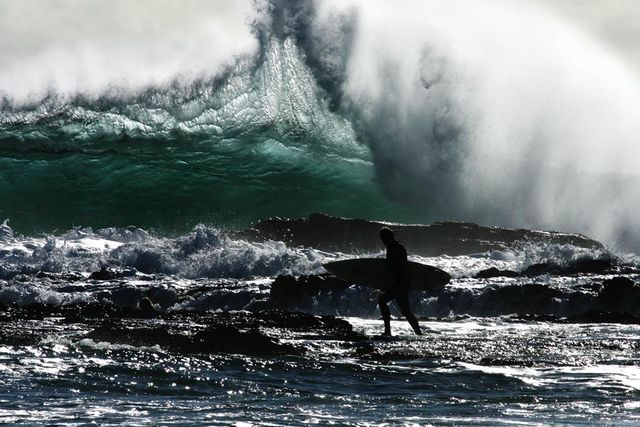
How do you pick your assignments?
It’s a funny way of how I stumble onto things. I guess I’m kind of young in the industry so I’m certainly not at a level where I get to pick and choose what I want. The Pakistan gig actually came from a trip where I went to Nepal and I met the world acro paragliding champion Horacio Llorens. He told me he was going to Pakistan and I waited for two years and we finally made it happen last year. I think it’s through constant networking. I got these BASE assignments through constant connection with the BASE community. I kept hanging out with them and photographing and sort of kept pushing them, and they were like, we’re going to do this thing.
Do you BASE jump?
BASE jumping is a sport I won’t actually do myself, just because it’s a very fine line between going for that photo and having to put yourself in there. Two years prior to our trip, there was a death as the jumper was more focused on setting his cameras up and worrying about the angle rather than paying more attention to the difficulty of the jump. He had a bad take off and unfortunately he went in, or, he died. It makes you realize that when it comes to certain sports, if you are not in it 110 percent, then you may as well not start.
How did the Baffin Island shoot come about?
Baffin Island is such a hot spot for BASE jumping. I mean, you don’t have to worry about boulders, or trees on the landing, or rangers trying to chase you down. Through a network there ended up being 23 BASE jumpers on this trip and it was simply through getting to know others that I got to go.��
Can you tell me a bit about the trip?
We went from mid-April to mid-May, because in Baffin the window for adventure guides to access Sam Ford Fjord is getting shorter. Two weeks after we left, the entire fjord broke up. We spent a whole month camping on the ice. To get there, we flew into a small town called Clyde River, rode snowmobiles for about 80 miles with Inuits, and then set up camp. The first two weeks was awesome weather. We were just spoiled stupid, and the next thing we knew, for the last two weeks, the opportunities to jump got pretty slim.
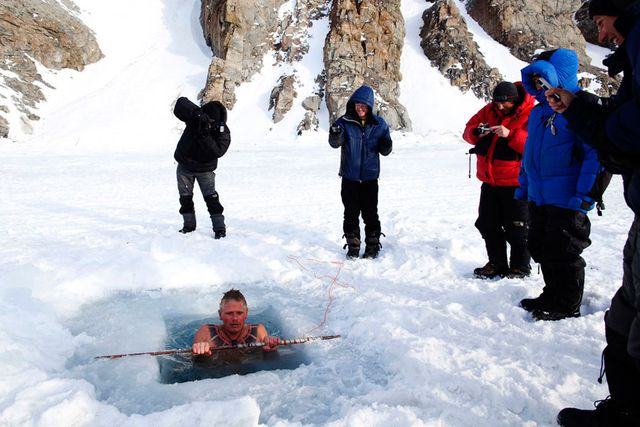
Is that why there is a guy bathing in the ice water? Typical BASE jumpers—they get pretty bored when they can’t jump.�� So one of the exercises included an ice bath. Not everyone got in there, but that guy Ted in the photo got in a couple of times. I’m not really sure what the purpose was, other than to pass time. And then the other time we got bored, they built an igloo.��
What was the temperature like? It totally changed. Some days it was warmish, -2. And that wasn’t a good thing, because the frost on top of your tent would melt and your sleeping bag would get soaked. But there’d be days when the wind chill made it to minus 20 if not lower. My cameras were so cold I couldn’t actually hold on to them some times. The temperatures were incredibly variable and averaged between -20 and zero. (That’s Celsius.)
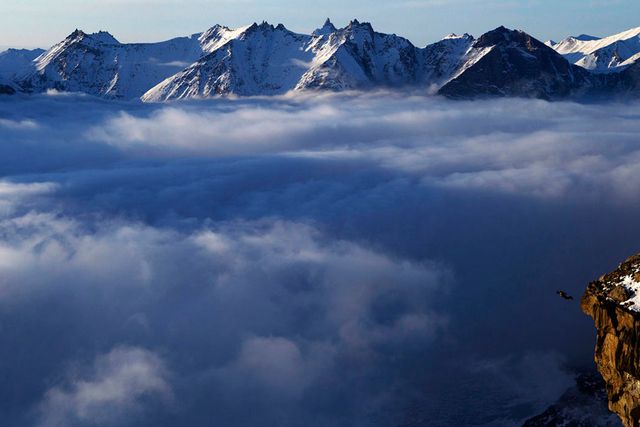
Was the cold the toughest part of shooting there?
It was crazy. The first two weeks were no worries, but then the mentality sinks in. Me being from Australia, I love the hot climate. You get off a hike, you get back, and you think, “Wouldn’t it be great to have a hot shower?” And then, “Oh, that’s right, you just got your little travel wash.” And of course it would be frozen if you hadn’t slept with it, and you have to change into your other dirty clothes that were supposed to be cleaner than your hiking clothes, and then jump into your sleeping bag. So, it was certainly one hell of an adventure. But there were times I was waiting for an hour for the others to get ready to jump and I was just frozen solid. It’s actually in that shot with the guy jumping off and the clouds rolling in. My hands are frozen solid. Just figuring out how to deal with the cold, and get the shot, and get back down to base camp was difficult. [Because everyone else jumped] I had to get back down solo. And I didn’t have a gun on me, so if a polar bear was there, I was pretty much screwed. The Inuits assured us that the polar bears were mostly out on the sea ice, and for us to see them would be not too common.
Do you have a favorite shot?
I think the last shot where you see the base camp and the three guys in the distance. I like that shot because it was just by chance that I saw that happen. It’s quite cool when you don’t plan something. That shot kind of sums up everything. You can see the base camp, the fjord, and, of course, guys jumping. But also there is that other action shot where you see the guy in the wingsuit jumping off. And that’s one of my favorites because the shot is of my friend , the one that invited me on the trip, and sadly he had a fatal accident 6 days before the trip ended. He died doing what he loved to do.
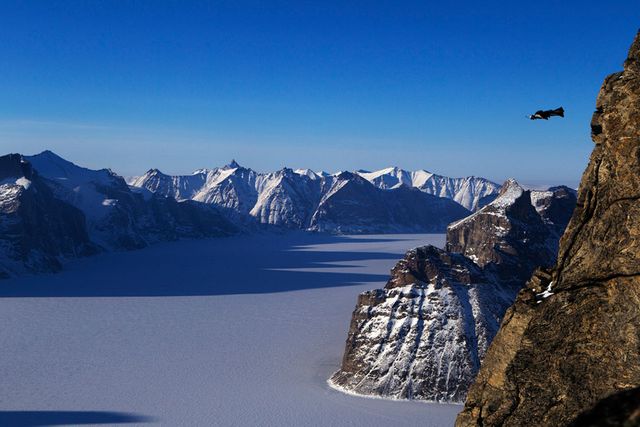
How did it happen?
They were climbing a different technical jump. He jumped and the other jumpers still on exit and I didn’t hear a thing. So after everyone jumped, I climbed back down as per usual. Upon reaching the bottom, they broke the news to me then. When you jumped, you had to sort of fly around the corner, and they just never saw him come around the corner. We’ll never truly know what went wrong that day. It hurt like hell when we came to the conclusion that we couldn’t rescue his body as he was too far down the cliff face. The next day on another rescue attempt after the blizzard had passed, the team couldn’t see him anymore. Unfortunately, the army pulled out because the risk was far too great to rescue the body and the family had to make the call to leave him behind.
Is dealing with death the hardest part of your job photographing extreme sports?
You know it can happen. But when it does happen it hits you pretty hard. You try and minimize the risk. Everyone loves the adventure and that’s just the negative side of what can happen.
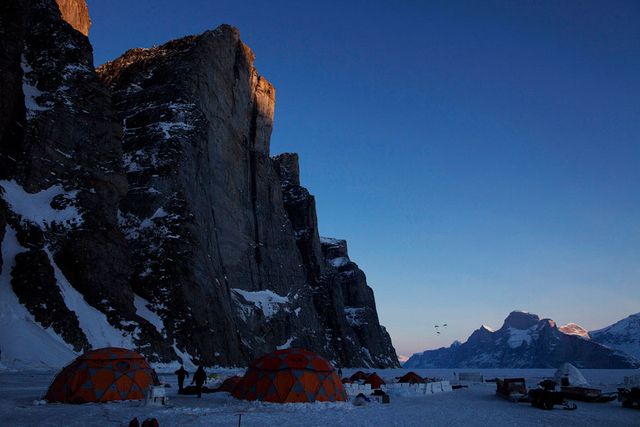
What do hope the reader comes away with looking at these pictures?
I hate it when people look at a photo and they dissect it trying to force a meaning out of it. I kind of like when people look at a photo and can just go, “Holy shit, that’s awesome.” Or get some sort of an instant reaction. If I can just inspire people to just get out there and do whatever it is that they love, that’s a pretty good feeling. And it’s also about showcasing some pretty unique things—and being able to tell these athletes’ stories.
–Joe Spring